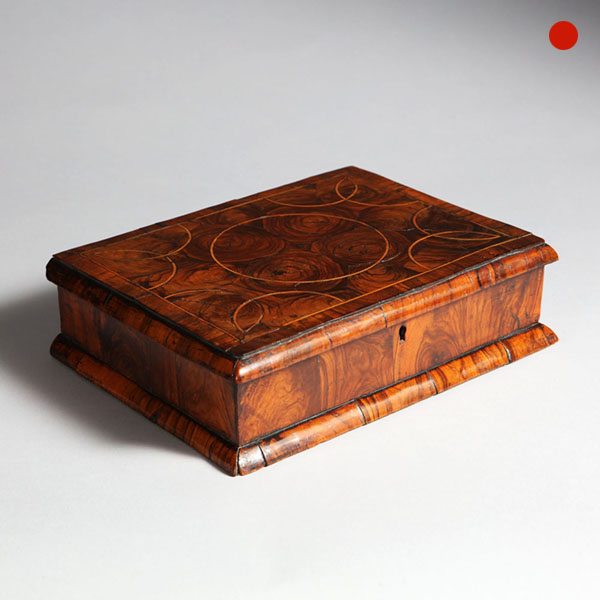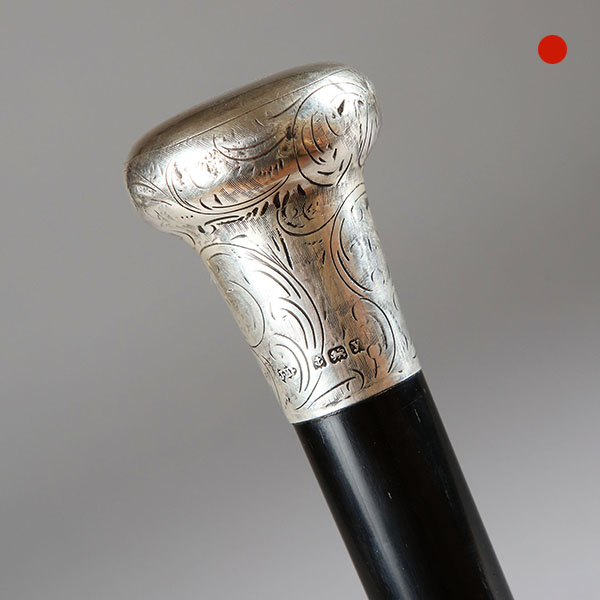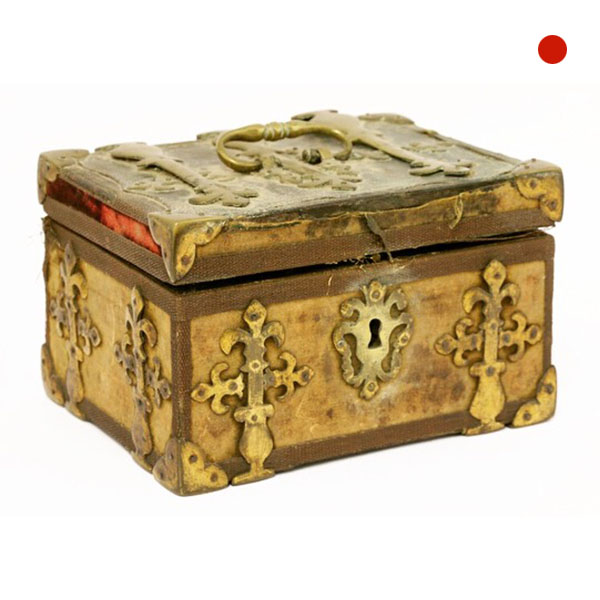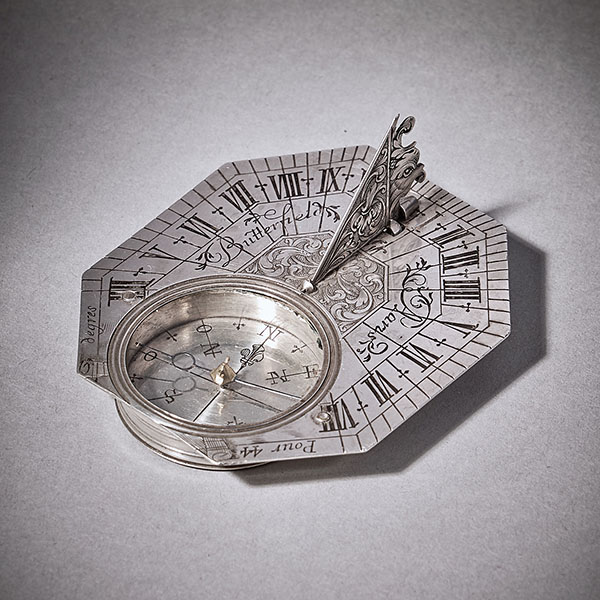Large Pair of Blue and White Baluster Vases and Covers
1800 to 1911 China
Sold
Request Information
Follow Us
Large Pair of Blue and White Baluster Vases and Covers
Each jar is decorated with four reserves on a ground of scrolling flowers. The domed covers are surmounted by a finial.
LATE QING DYNASTY (1644-1911)
Two ‘Photoshopped’ examples with the vases turned into lamps.
Condition
Superb
Dimensions
H 20.08 in. x Dm 11.03 in.
H 51 cm x Dm 28 cm
PREVIOUSLY SOLD

Charles II Pewter Flat Lid Tankard
The Oak Interior – An extremely rare Charles II pewter tankard dated 1666. The tankard bears a crested stamp dated 1666 to the inside of the base. The flat caddy and ringed lid are stamped to the top with four hallmarks of the period and the initials C B. The beautifully crafted handle terminates at a bifurcated rams horn hinged thumb piece and the vessel sits on a multiple ringed and flared base.

17th-Century Olive Oyster Lace Box
Charming and original 12” olive oyster lace box, circa 1680-90. It is most likely that this gorgeous piece was commissioned during the short reign of William and Mary (1689-1702). This was a great time in British furniture design with some of the most notable pieces to date being commissioned.

A lacquer kodansu (small cabinet) | Edo period, 19th century
A lacquer Kodansu, Edo period, 19th century Follow UsA lacquer Kodansu Edo period 19th century The rectangular chest with chamfered edges and a hinged door opening to reveal three drawers, all decorated in gold, silver, red and black...

Engraved silver-topped ebony walking cane. Dated 1923 Birmingham
Silver-topped Ebony Walking Cane of outstanding quality and effortless elegance. Tapering ebony cane with a beautifully engraved silver cap.

17th-18th Century Silk Covered Strongbox Jewel Casket
17th-Century Silk Covered Strongbox Jewel Casket. Occasionally an object can certainly grab your imagination, this casket of small proportions is no exception.

Charles II Kingwood Oyster Lace Box
An extremely rare Charles II kingwood oyster lace box 1660-1675. The box through its kingwood (also known as princeswood) oysters laid in a parquetry fashion, relate closely to an important and exceptionally rare triad set, in private collection at Dryton House.

Charles II Pewter Flat Lid Tankard
The Oak Interior – An extremely rare Charles II pewter tankard dated 1666. The tankard bears a crested stamp dated 1666 to the inside of the base. The flat caddy and ringed lid are stamped to the top with four hallmarks of the period and the initials C B. The beautifully crafted handle terminates at a bifurcated rams horn hinged thumb piece and the vessel sits on a multiple ringed and flared base.

17th-Century Olive Oyster Lace Box
Charming and original 12” olive oyster lace box, circa 1680-90. It is most likely that this gorgeous piece was commissioned during the short reign of William and Mary (1689-1702). This was a great time in British furniture design with some of the most notable pieces to date being commissioned.

A lacquer kodansu (small cabinet) | Edo period, 19th century
A lacquer Kodansu, Edo period, 19th century Follow UsA lacquer Kodansu Edo period 19th century The rectangular chest with chamfered edges and a hinged door opening to reveal three drawers, all decorated in gold, silver, red and black...

Engraved silver-topped ebony walking cane. Dated 1923 Birmingham
Silver-topped Ebony Walking Cane of outstanding quality and effortless elegance. Tapering ebony cane with a beautifully engraved silver cap.

17th-18th Century Silk Covered Strongbox Jewel Casket
17th-Century Silk Covered Strongbox Jewel Casket. Occasionally an object can certainly grab your imagination, this casket of small proportions is no exception.

Charles II Kingwood Oyster Lace Box
An extremely rare Charles II kingwood oyster lace box 1660-1675. The box through its kingwood (also known as princeswood) oysters laid in a parquetry fashion, relate closely to an important and exceptionally rare triad set, in private collection at Dryton House.
YOU MAY ALSO LIKE

Rare Silver Pocket Sundial and Compass by Michael Butterfield, Paris, circa 1700
Rare Silver Pocket Sundial and Compass by Michael Butterfield, Paris, circa 1700 £4,900 Follow UsRare Silver Pocket Sundial and Compass by Michael Butterfield, Paris, circa 1700 A beautiful, rare solid silver Anglo-French octagonal pocket...

Engraved Eight-Day Striking and Repeating Carriage Clock by Perregaux Au Locle
Engraved Eight-Day Striking and Repeating Carriage Clock by Perregaux Au Locle Follow UsEngraved Eight-Day Striking and Repeating Carriage Clock by Perregaux Au Locle The superb engraved gilt gorge brass case has facetted glass panels to all...

Fine George III 18th Century Period Mahogany Longcase Clock by Tomas Fowle
18th Century Period Mahogany Longcase Clock by Tomas Fowle £12,995 Follow Us18th Century Period Mahogany Longcase Clock by Tomas Fowle A fine George III period mahogany longcase clock of excellent colour, patination and proportions, circa...

17th Century Figured Walnut and Seaweed Marquetry Lace Box
17th Century Figured Walnut and Seaweed Marquetry Lace Box £3,600 Follow Us17th Century Figured Walnut and Seaweed Marquetry Lace Box A fine and extremely rare figured walnut and seaweed marquetry 'lace box', circa.... let’s break it down -...

19th Century Repeating Gilt-Brass Carriage Clock by the Famous Drocourt
19th Century Repeating Gilt-Brass Carriage Clock by the Famous Drocourt £5,600 Follow Us19th Century Repeating Gilt-Brass Carriage Clock by the Famous Drocourt A superb repeating carriage clock with a gilt-brass gorge case by the famous maker...

17th-Century Hague Clock Signed by Pieter Visbagh, circa 1675
Small 17th Century Hague clock made c. 1675 by Pieter Visbagh, who was apprenticed by Salomon Coster. The latter made the first pendulum clock according to the instructions of Christiaan Huygens, the internationally renowned scientist who developed the idea of applying a pendulum to a clock movement.

Rare Silver Pocket Sundial and Compass by Michael Butterfield, Paris, circa 1700
Rare Silver Pocket Sundial and Compass by Michael Butterfield, Paris, circa 1700 £4,900 Follow UsRare Silver Pocket Sundial and Compass by Michael Butterfield, Paris, circa 1700 A beautiful, rare solid silver Anglo-French octagonal pocket...

Engraved Eight-Day Striking and Repeating Carriage Clock by Perregaux Au Locle
Engraved Eight-Day Striking and Repeating Carriage Clock by Perregaux Au Locle Follow UsEngraved Eight-Day Striking and Repeating Carriage Clock by Perregaux Au Locle The superb engraved gilt gorge brass case has facetted glass panels to all...

Fine George III 18th Century Period Mahogany Longcase Clock by Tomas Fowle
18th Century Period Mahogany Longcase Clock by Tomas Fowle £12,995 Follow Us18th Century Period Mahogany Longcase Clock by Tomas Fowle A fine George III period mahogany longcase clock of excellent colour, patination and proportions, circa...

17th Century Figured Walnut and Seaweed Marquetry Lace Box
17th Century Figured Walnut and Seaweed Marquetry Lace Box £3,600 Follow Us17th Century Figured Walnut and Seaweed Marquetry Lace Box A fine and extremely rare figured walnut and seaweed marquetry 'lace box', circa.... let’s break it down -...

19th Century Repeating Gilt-Brass Carriage Clock by the Famous Drocourt
19th Century Repeating Gilt-Brass Carriage Clock by the Famous Drocourt £5,600 Follow Us19th Century Repeating Gilt-Brass Carriage Clock by the Famous Drocourt A superb repeating carriage clock with a gilt-brass gorge case by the famous maker...

17th-Century Hague Clock Signed by Pieter Visbagh, circa 1675
Small 17th Century Hague clock made c. 1675 by Pieter Visbagh, who was apprenticed by Salomon Coster. The latter made the first pendulum clock according to the instructions of Christiaan Huygens, the internationally renowned scientist who developed the idea of applying a pendulum to a clock movement.






